What can you expect when two titled heavyweights enter the ring? That’s right – a long, exciting duel.
Kentico Xperience and Sitecore are digital experience .NET platforms offering a wide range of functionalities. Choosing the right platform requires considering many factors: content management, infrastructure, security, scalability, integration with external systems and services, pricing, and, last but not least, marketing features.
Every company has unique business needs, individual business models, and a distinct online marketing approach, so selecting an appropriate DXP platform requires a detailed analysis. Nevertheless, after working on more than a dozen projects based on Sitecore (versions 7.x, 8.x, and 9.x) and Kentico (versions 11.x and 12.x), I came to some conclusions that might help you choose a platform better in satisfying your marketing needs.
The beginning: weigh-in
Kentico Xperience and Sitecore are mature content management systems with built-in online marketing tools. At first glance, both platform’s marketing ecosystems offer relatively similar features, so selecting a better one can be tricky. One may bring down online marketing needs to general concepts like:
- web analytics,
- activity tracking,
- content personalization,
- segmentation, or
- email communication.
Herein I will analyze the implementation of the most important marketing concepts in Kentico and Sitecore platforms. The assessment will be subjective — I will do it from the perspective of an online marketer. I will consider the flexibility of tools offered out of the box by each DXP. I’ll evaluate the range of customization that a marketer can achieve without the backend developer.
Round 1: Analytics and reporting
Appropriate dashboards and reports allow you to make smart decisions about user segmentation, marketing budget, assessing the campaign activities effectiveness, and content optimization. Both platforms offer built-in basic web analytics modules showing various reports depicting how users engage with the website.
Kentico dashboards are simpler to modify and, to some extent, can be customized from the level of the user interface. On the other hand, Sitecore offers a broader range of reports. Sitecore Path Analyzer tool offers unique visualizations of paths undertaken by website visitors. The creation of similar reports in Google Analytics is difficult and time-consuming, whereas Sitecore provides them out of the box.
And the winner is… Sitecore — It offers a more sophisticated analytical subsystem. Nevertheless, it is necessary to use an external dedicated analytical system like Google Analytics in both Kentico and Sitecore.
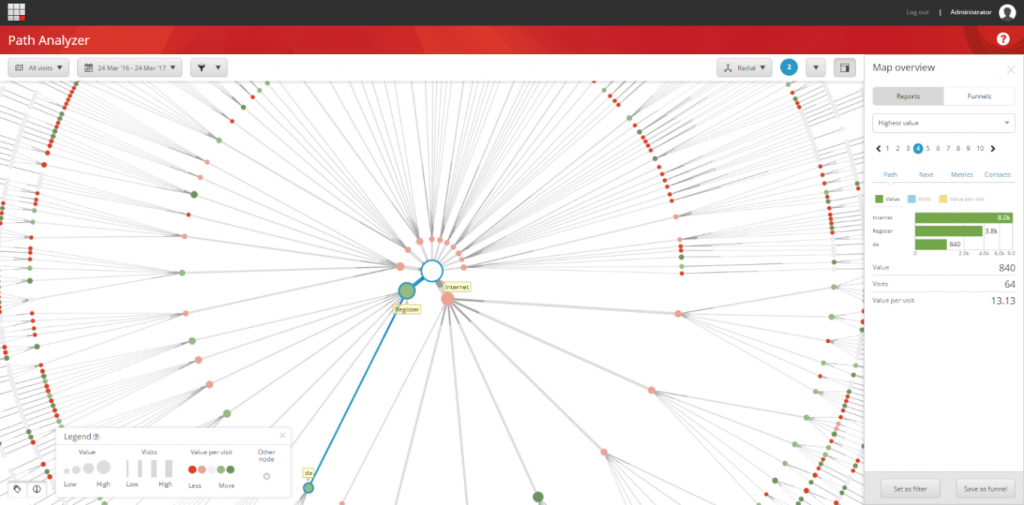
Round 2: Conversion tracking
Both platforms enable tracking conversion activities. Sitecore calls them goals, while Kentico calls them merely activities. Associating conversion with the click action of a selected button almost always requires a backend developer.
In Sitecore UI, it is possible to associate a goal with a page visit, which is a helpful workaround in some cases.
And the winner is… Let’s call it a tie. The practical functionalities and limitations of both platforms are very similar in this area.
Round 3: Campaign tracking
Both platforms enable tracking visitors who entered your page from tagged links placed in newsletters, external sites, or social media posts. Adding unique UTM parameters to such links enables the DXP system to personalize content for such users and undertake marketing activities like sending dedicated emails. What is more, it is possible to track the overall performance and conversion rates of traffic generated with each campaign.
And who won this round? Again, let’s call it a tie. Campaign tracking capabilities of both platforms are equal.
Round 4: Lead scoring
Scoring enables assigning value points to specific actions undertaken by site visitors. In Sitecore, the marketer is limited to only one scoring, summing the engagement value of goals. The advantage of Sitecore over Kentico is the possibility of defining a “decay rate” — a percentage number expressing the relevancy of the profile over time. What is more, Sitecore offers OOTB basic personalization rules checking points gathered by users.
In Kentico’s case, it is necessary to develop such rules (they are not available OOTB). On the other hand, Kentico enables you to define multiple scorings so that one can perform lead scoring multidimensionally. What is more, the process of defining scored activities and attributes in Kentico is much more flexible.
It looks like Kentico is a winner of this round — It offers broader possibilities of utilizing lead scoring mechanisms.
Round 5: Basic rule-based personalization
Both platforms offer a wide range of OOTB rules that can be used to define to whom the website should display certain personalized content. The Sitecore platform’s current version seems to have a higher number of useful rules in practical applications; what is more, personalization rules can be attached directly to almost every module of the page.
In the Kentico MVC model, it is necessary to define personalization conditions using Contact_Groups. At first, it may look like a weird workaround, but it becomes a big timesaver when the same set of personalization rules is used in multiple places. Kentico allows users to create custom personalization rules (in the case of Kentico, they are called macro rules) using well documented K# language. Creating custom personalization rules in Sitecore always requires a development process.
At the same time, Kentico enables you to create custom macro conditions from the UI level in many cases without the need to bother your developers. Usually, the process of personalizing the webpage utilizes around five unique OOTB rules and requires developing about 2 or 3 custom rules.
What is worth mentioning, rule editor of Kentico enables combining multiple macro conditions and nesting them. In contrast, the Sitecore platform’s corresponding editor limits the possibility of creating a more elaborate combination of nested rules (of course, it can be worked around and does not limit the marketer, but it may prolong the configuration of the personalized content).
And the winner is Kentico again. Both personalization engines are cutting-edge, powerful, and well developed, but Kentico seems to give more possibilities to marketers who don’t have developer competencies.
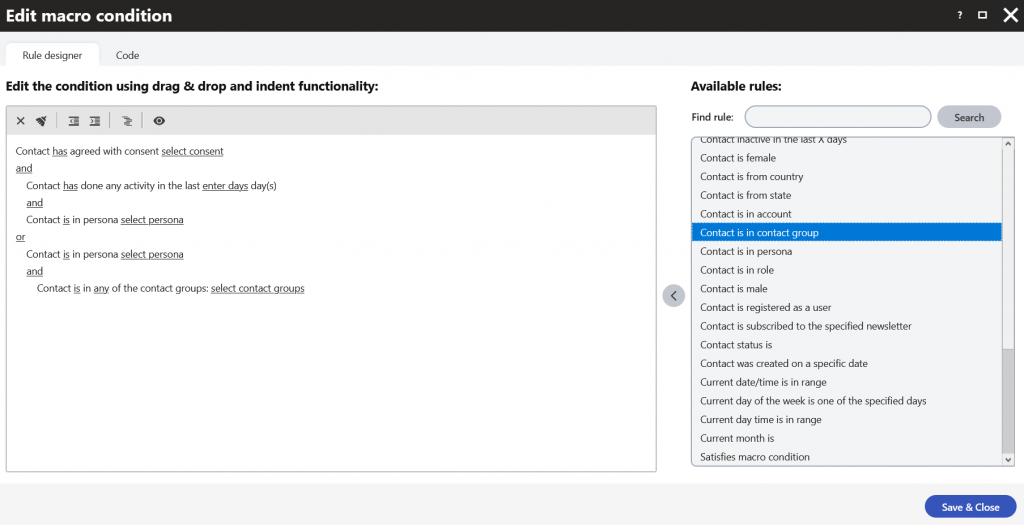
Round 6: Advanced personalization based on a digital fingerprint
Let’s look at the possibilities of tagging the content and dynamically segmenting page visitors to deliver the content that will be the most interesting for each user.
Personas in Kentico are limited to one dimension only. It works well in many projects but requires searching for workarounds in the case of multidimensional personalization scenarios. Sitecore offers a content profiling system that, at first glance, seems to be complicated — the mixture of profiles, keys, pattern cards, profile cards, and all the values is tricky.
Still, after a careful lecture on documentation, you will be able to satisfy even the most elaborate needs connected with dynamic personalization based on the digital fingerprint.
And the winner of round 6 is Sitecore — It offers more flexibility by allowing you to create multidirectional personas and profiles.
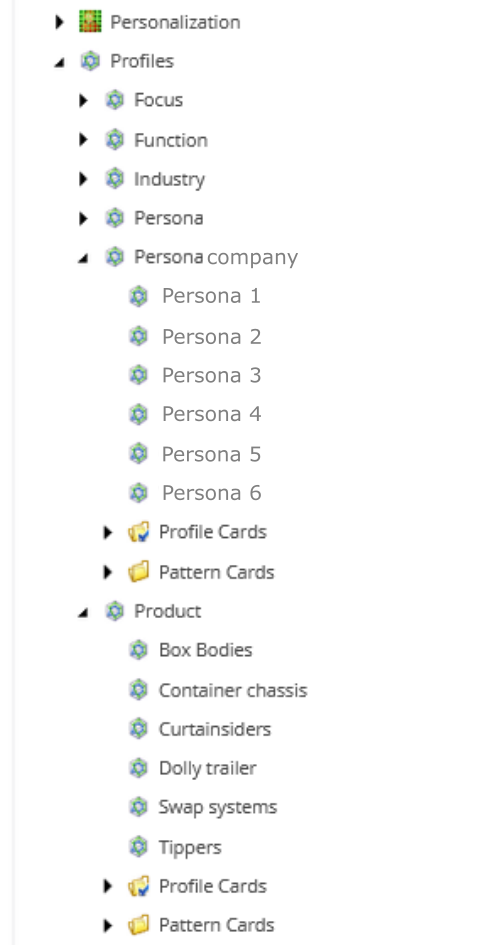
Round 7: Contact management
Both platforms enable marketers to analyze profiles (data of all visitors — both registered and anonymous). A unique feature of Kentico is the possibility to create new status fields directly from UI. What’s more, Kentico enables defining contact groups (this feature is especially useful in B2B platforms).
It’s hard to name a clear winner of this round, so let’s call it a tie. Kentico and Sitecore offer similar capabilities for contact management. Differences in this area are minor. It is worth mentioning that both platforms enable you to achieve full compliance with GDPR requirements.
Round 8: Testing
Sitecore supports A/B and MVT testing of web content. Kentico supports only A/B tests. Both platforms automatically create reports presenting differences in engagement and conversion rates.
And the winner is… Sitecore — it is more flexible than Kentico. On both platforms, it is sometimes better or easier to perform some particular tests using Google Optimize.
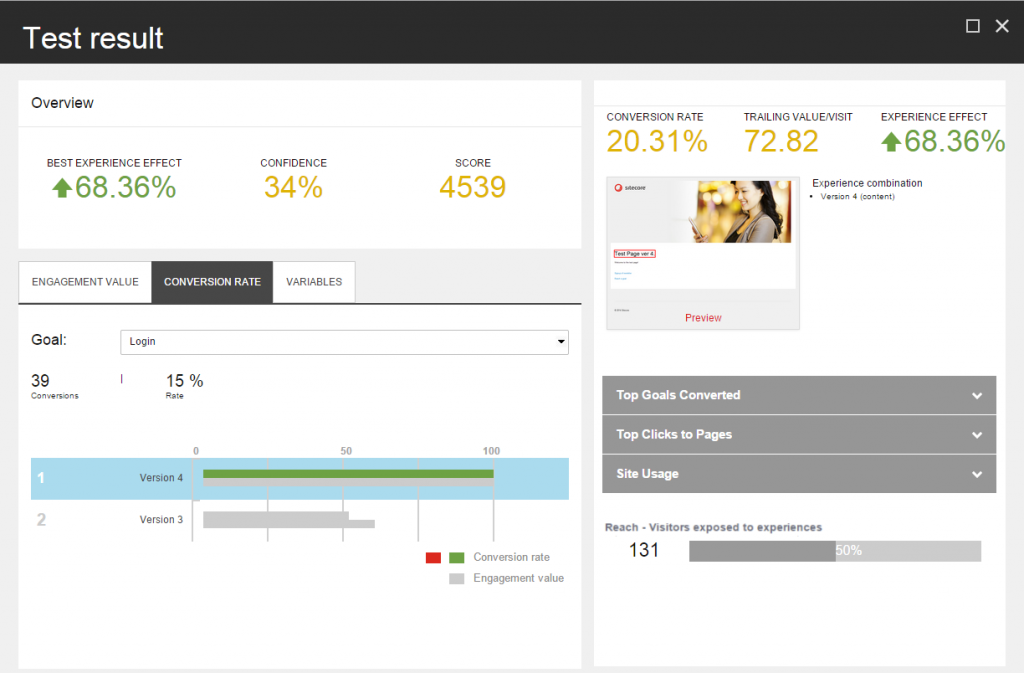
Round 9: Email marketing
Both platforms have dedicated recipient list managers and WYSIWYG email content creators. They both support personalization and enable you to perform A/B tests.
How about the winner? Well, let’s call it a tie. Email management tools of both platforms are top-notch and offer the same functionalities.
Round 10: Automated email communication
Kentico offers a potent Marketing Automation module, which extends with each new version of the platform. Introduction of Sitecore 9 removed old problematic Engagement Plans and introduced a new Marketing Automation module that offers more or less the same functionalities as Kentico.
Do you want to create advanced and automated email campaigns? Do you want to react to message openings, link clicks, website activities, and conversions? Kentico and Sitecore enable the delivery of contextual email messages to the right people at the right time.
Yet again, we have a tie here. Both platforms offer similar email marketing automation features.
Of course, in practice, it may be necessary to develop custom functionalities extending Marketing Automation modules (for example, to send short text messages to mobile phones).
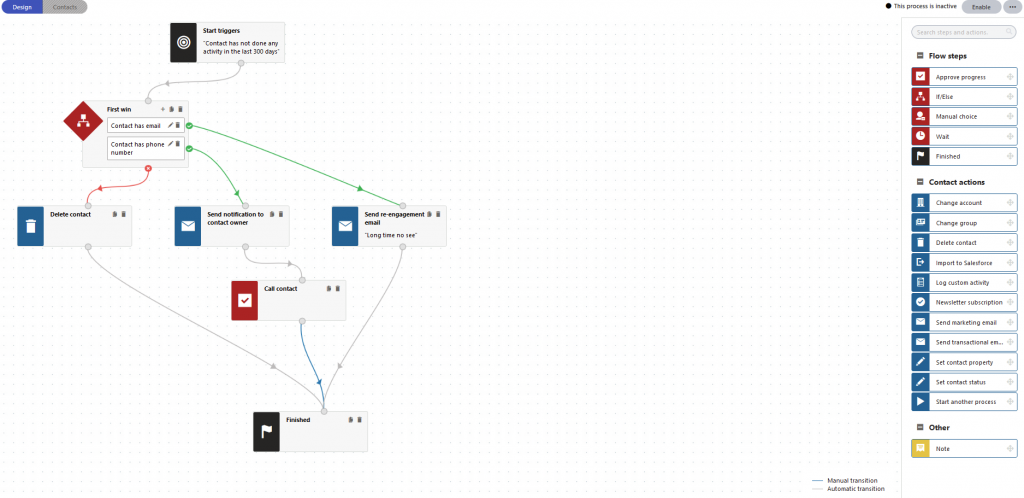
Round 11: Tracking activities on external sites
There’s no way to place all sites and services in the same CMS system in many corporations, but at the same time, one needs to track interactions with all sites and services to achieve a 360° customer view.
In the case of Kentico, such tracking requires developing custom solutions. Sitecore offers the Federated Experience Manager application, which is available OOTB.
This application enables adding Sitecore content on external websites. It also allows tracking visitors on sites which are non-Sitecore. One needs to add a JavaScript tag to external websites to allow such tracking. After that, a simple WYSIWYG editor enables you to configure tracking page visits and click actions.
Unfortunately, this WYSIWIG editor works correctly only with simple and static landing pages. Nevertheless, Sitecore also offers FXM JS API, which allows utilising tracking functionalities also in case of complex and dynamic web applications. Most importantly, the marketer or web analyst can use this API from Google Tag Manager, so frontend or backend developers’ help is unnecessary.
And the winner of this round is Sitecore — If you want to track the cross-platform customer journey, Sitecore will offer you all the necessary tools OOTB without the need to perform massive development
Round 12: Quality of technical support
It may happen that something is not working as it should, is working counterintuitively, or has some technical flaws. That is why dynamic technical support of the DXP platform is critical.
When one talks about technical support regarding marketing features, Kentico seems to be more user-friendly, responsive, and open to improvement suggestions.
In this round, the clear winner is Kentico — Of course, this is just a subjective opinion from a marketer’s perspective. In practice, it is worth carefully comparing the rules of support agreements of both platforms and considering your company’s essential factors.
Final verdict
So which one is better? Sitecore gained 9 points, and Kentico gained 8 points, so theoretically, Sitecore won this fight, but that does not mean that Sitecore is better than Kentico for your company.
Selecting the right DXP, even when it comes to marketing features only, is a very personal and subjective process. It requires careful analysis and prioritization of the business and technical needs of your company.
If your project requires complex and multidimensional personalization or implementation of cross-site tracking mechanisms, then Sitecore will offer you killer OOTB features and a better solution.
If your project requires sophisticated email marketing automation and you expect good value for money, then Kentico is a go.
Kentico Xperience and Sitecore EMS offer top-notch marketing features that are constantly expanded and improved. Over time, the title of “better marketing platform” may be transferred from one platform to another.







